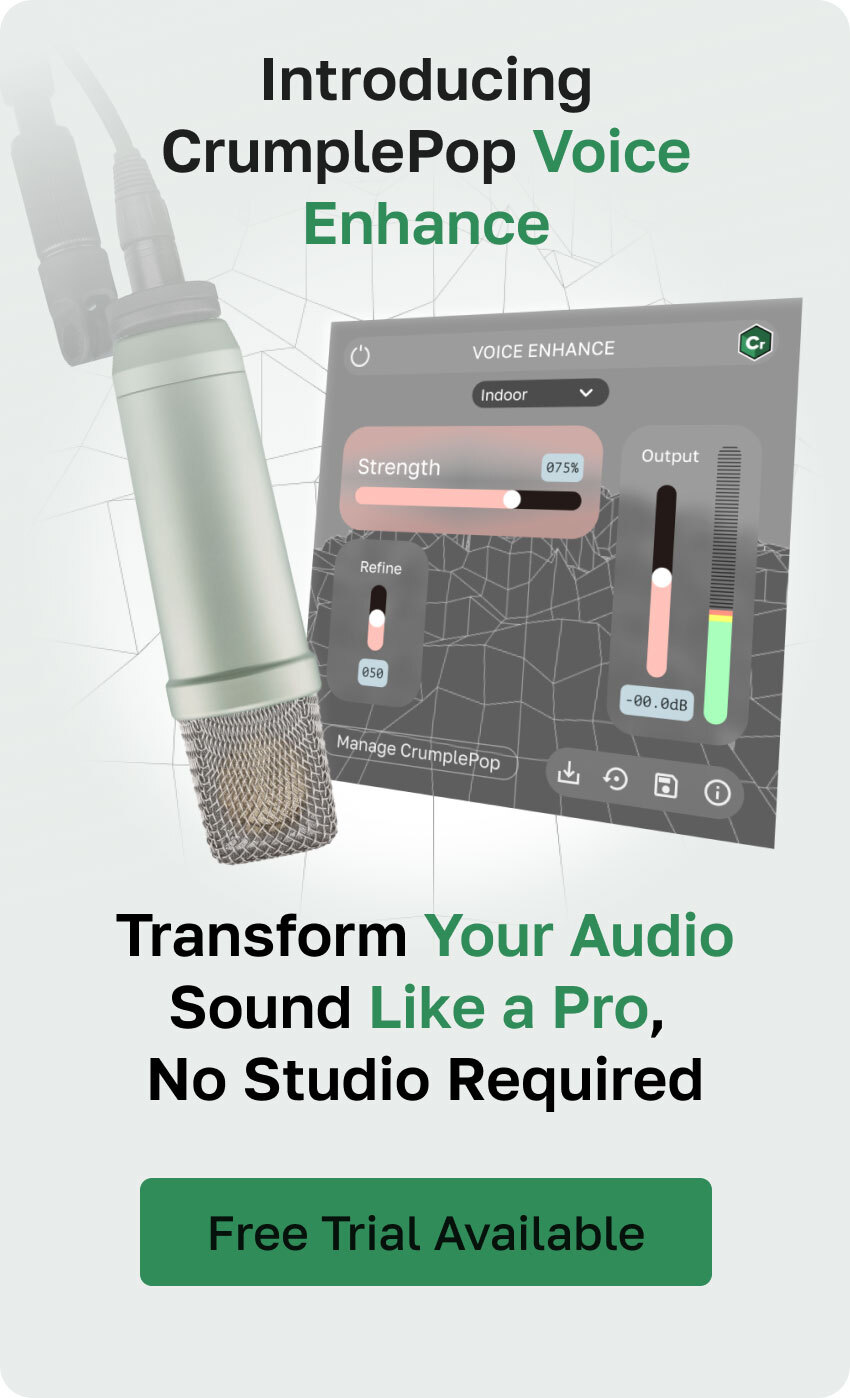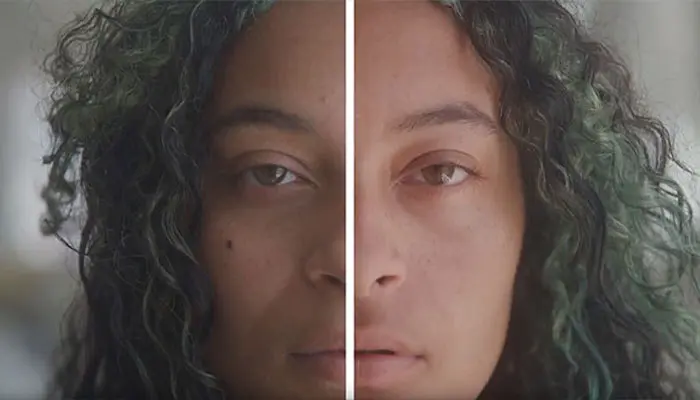Good audio quality is essential for successful productions in podcasting, vlogging, streaming, music production, and filmmaking.
Background noises, dogs barking, echoes, room tone, rumbles, traffic, and hissing sounds are common issues that you’ll need to address. However, blocking these noises in many situations is almost impossible, so our first step in post-production should be cleaning and repairing audio files to reduce noise.
In today’s article, I’ll compare two powerful audio repair tools: CrumplePop and iZotope RX. These are two very popular tools for audio restoration and post-production, each with unique traits and modules to achieve high-quality audio. I’ll dive into each program's main features, how they work, and their pros and cons to help you decide which one to use.
Let’s dive in!
CrumplePop Overview
Try Voice Enhance Now!
Instantly transform any voice recording into professional-quality sound with the power of AI. No internet access required- your audio stays private and secure. Toggle it on/off to hear the difference.
On-location Interview
Selfie-style Phone Audio
Zoom Call
Ridiculous Echo
Traffic Noise
Far from Mic
Untreated Room
Recording at Home
On-location Interview
If you’re looking for a tool that delivers studio-quality audio, can be used within your DAW or video editor, is quick to set for advanced editors, is easy to use for beginners, and does not require an audio engineer’s degree to tweak, look no further than CrumplePop.
CrumplePop is an AI-powered audio restoration tool for enhancing dialogue and vocal recordings. It is available in two formats: plug-in and desktop app. The app version is available for Mac and Windows, and the plug-in version can be used on Mac and Windows computers as VST3, AAX, and AU plug-ins inside programs such as Premiere Pro, Audition, Logic, GarageBand, Audacity, Pro Tools, Final Cut Pro, DaVinci Resolve, and more.
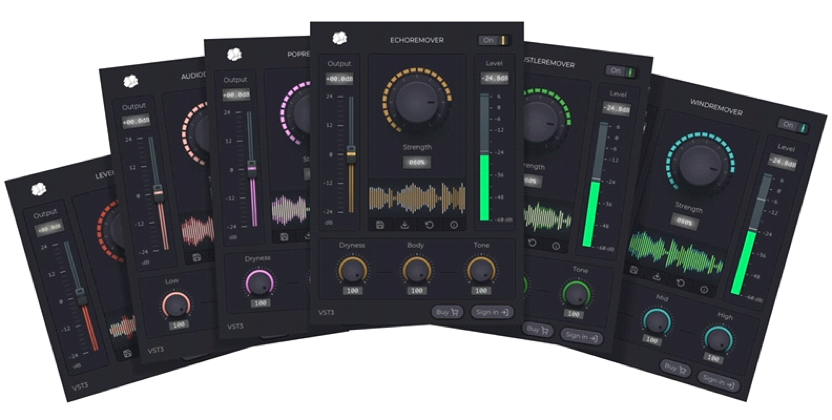
CrumplePop offers various dedicated tools for specific types of noises. Voice Enhance cleans audio files and enriches the clarity of the voice track, especially for those recording on non-professional equipment such as laptop and mobile device microphones. The full suite includes Voice Enhance plus AudioDenoise, WindRemover, PopRemover, RustleRemover, TrafficRemover, ClipRemover, Levelmatic, and EchoRemover.
Main Features:
- Voice Enhance is an AI-powered vocal enhancer for noise removal and improved dialogue.
- Designed plug-ins for different types of noise, such as background noise, wind, traffic, pops, clicks, echo, and lav mic rustles.
- Audio is processed locally on your computer.
- Real-time processing.
- Desktop and plug-in versions (AU, AAX, and VST3).
- Supports mp3, mp4, mov, .mkv, .ogg, .H.264, MPEG-4, MPEG-2, AAC, and OGG audio formats.
- Click and drag and drop plug-ins.
- Beginner-friendly interface.
- Customizable with simple controls.
- Save presets to use in other projects and compatible software.
How CrumplePop Works
Let’s briefly explain how CrumplePop can improve audio quality with such a simple-to-use tool. CrumplePop uses AI models and machine learning to analyze audio files, identify vocals from noise, and apply noise reduction to the noise only without affecting the vocal part.
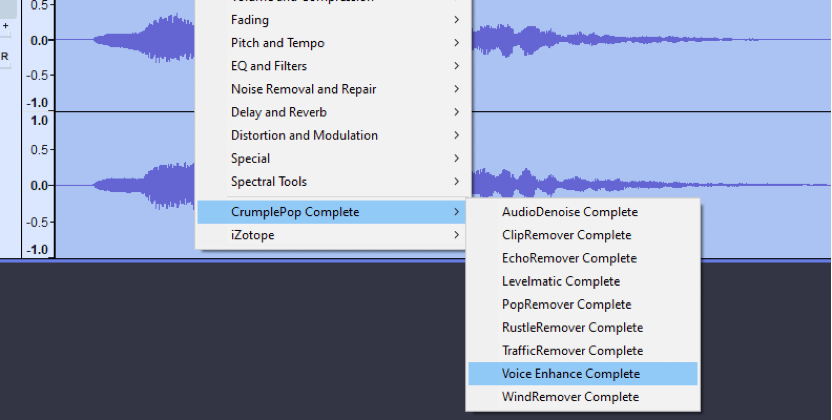
Each of the CrumplePop suites uses these technologies. However, starting with Voice Enhance is recommended, as this is the most advanced AI-powered tool in the suite. It works with three models the user selects to analyze and repair audio: indoor, indoor-noisy, and outdoor.
The models target three scenarios: indoor locations, indoor recording locations without good acoustics and soundproof treatment (or noises from other people, common in home studios or meeting recordings), and outdoor recordings where traffic, wind, and unwanted external noises are a big issue.
Depending on your scenario, the AI algorithm will apply the effect immediately, which you can then adjust to your needs. The rest of the plug-ins in the CrumplePop suite can be used before Voice Enhance, with even simpler controls to adjust strength. Of course, you can add other audio effects from your DAW, such as reverb, compression, and EQ, in your vocal chain.
One thing to highlight is that, unlike many other AI online tools, CrumplePop does not require you to be connected to the internet because it processes all the audio files on your computer.
How to Use CrumplePop
To apply CrumplePop, select your audio clip and click and drag it from your audio effects library. If you can’t find it under the VST/AU plug-ins, try searching on the audio restoration or CrumplePop Complete subfolders.
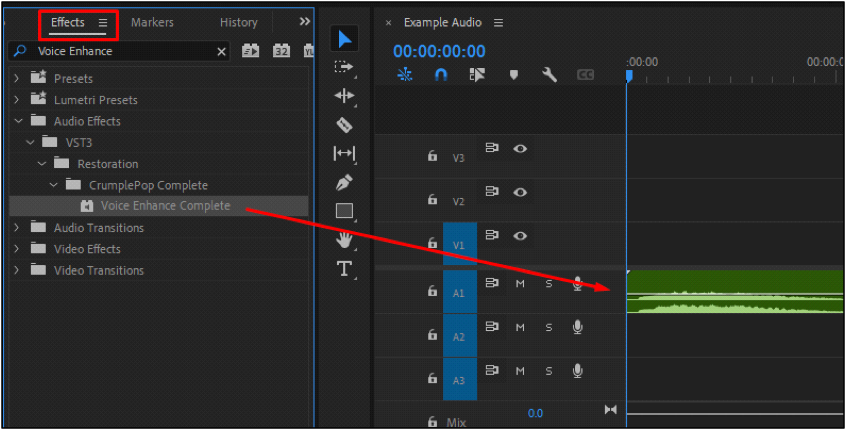
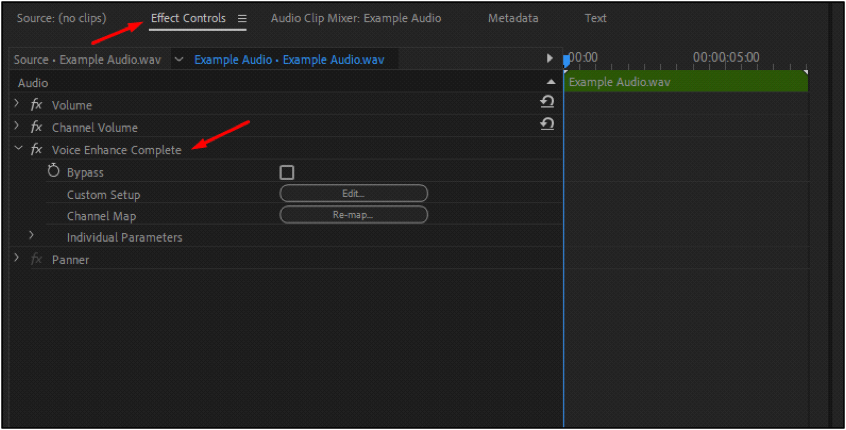
Start with Voice Enhance to clean up most audio problems. The good thing about Voice Enhance is that you can apply it to the audio clip or an audio track to work with multiple clips. Then, you can pinpoint specific noises that are still audible by applying other CrumplePop plug-ins upstream.
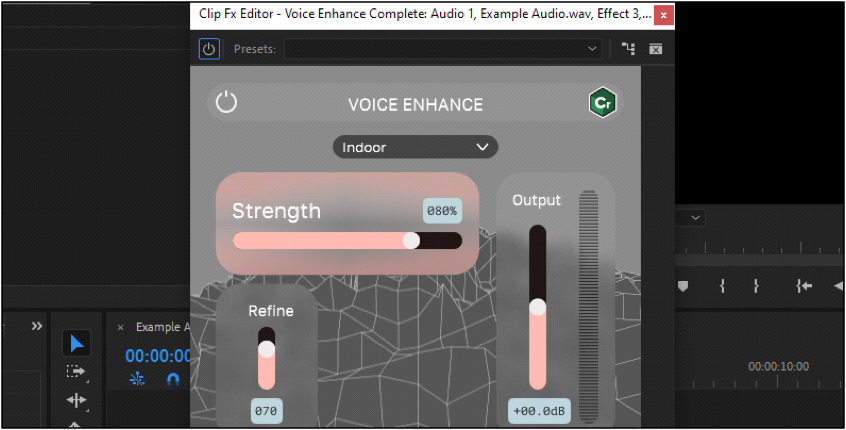
The plug-in's UI is very straightforward. With Voice Enhance, select the model you want to use, set the strength, and refine the effect using the sliders. The rest of the plug-ins are even simpler by adjusting the Strength knob and tweaking the Low, Mid, and High controls until you reduce the unwanted noise.
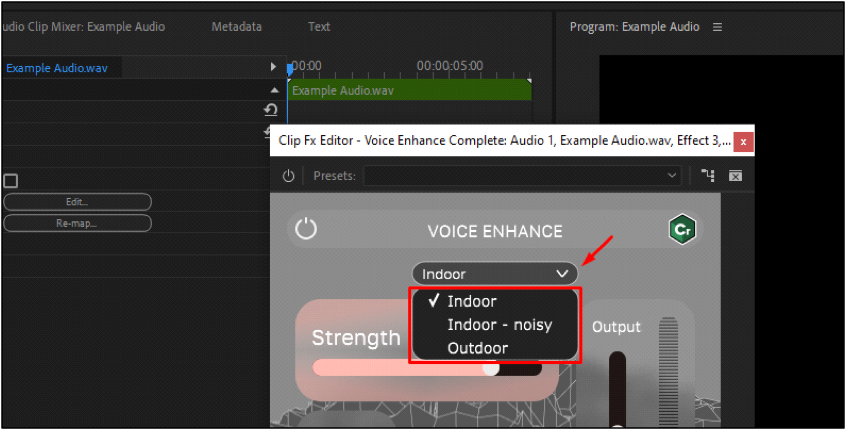
To use SoundApp, CrumplePop's desktop application, import your audio file. Then, select the required audio tool and adjust the settings using the slider or the plug-in UI. Save your changes, and now you can import the audio files to a DAW or video editor.
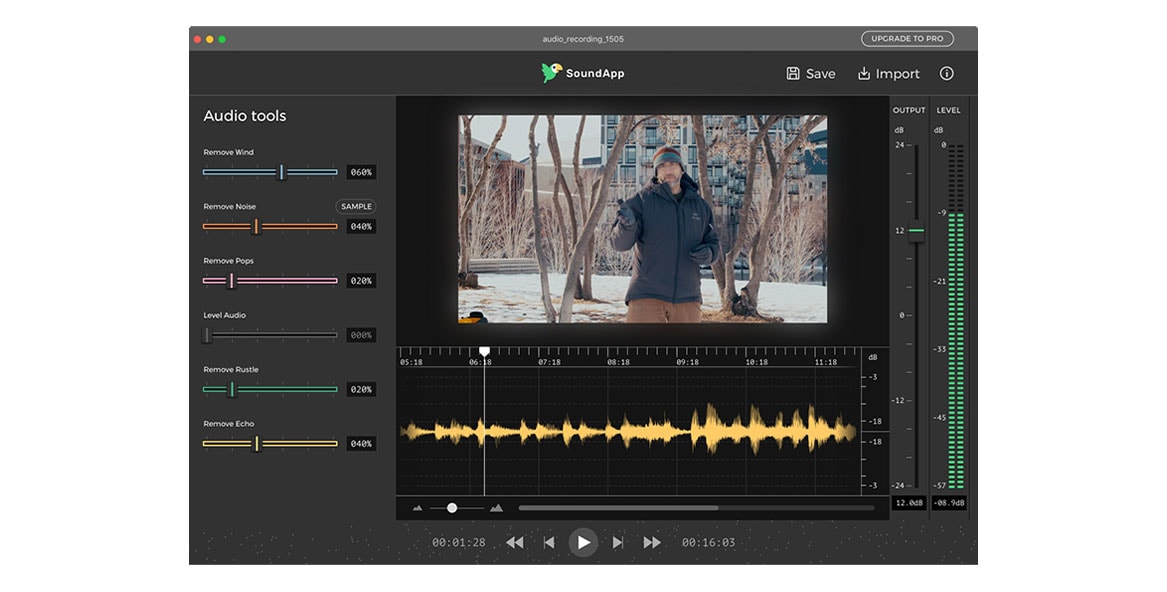
Price:
The Starter plan is a free trial version that includes full versions of RustleRemover and PopRemover.
The CrumplePop subscription plan packs every plug-in for $18 monthly or $180 yearly ($15 monthly billed annually). The drawback is that it’s only for one host in either VST or AU. If you want, the multi-host version is $29 monthly or $276 yearly ($23 monthly billed annually).
If you prefer to pay once, the perpetual license is $599, including the multi-host version. If you have a license for a previous version license, renewing your license to get the new upgrades and support costs $196.
Pros:
- Multi-host plug-in.
- Includes Voice Enhance AI-powered audio enhancer.
- Dedicated tools to target specific audio issues.
- Easy to use and beginner-friendly.
- Quick and real-time processing.
- Local audio processing.
- Plugin and desktop apps are available.
- Multiple payment options.
- Limited free version.
Cons:
- You can’t buy single plug-ins.
- Not available for Linux, 32-bit systems, and older Mac and Windows versions.
- It can be high on CPU resources.
- It may feel limited if you like to tweak parameters and EQ bands manually.
iZotope RX Overview
Now, let’s talk about iZotope RX. iZotope is a company known for developing professional audio tools for audio recording and post-production, including mixing and mastering software. In its audio restoration product line, iZotope offers RX.
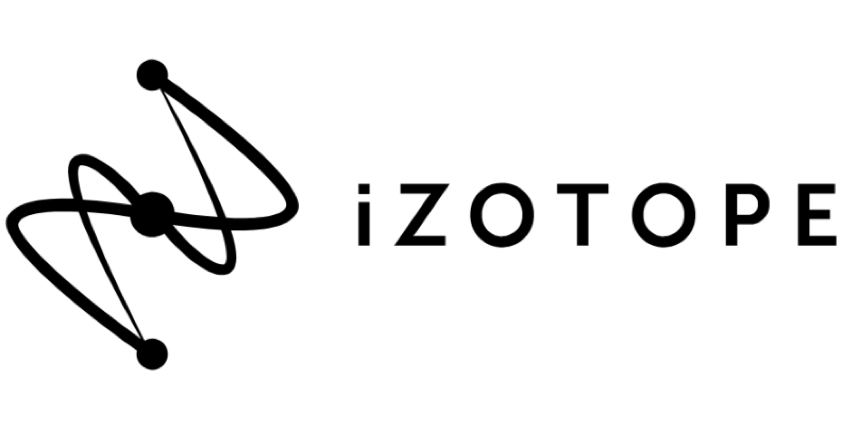
iZotope RX is an ML-powered audio repair and enhancement tool capable of fixing common audio issues and restoring inaudible audio for video content and even old recordings that you may think are irreparable.
It's available as a standalone app for Mac and Windows systems and supported as AU, AAX, and VST3 plug-ins inside supported hosts, including Pro Tools, Ableton Live, Cubase, Nuendo, Studio One, Premiere Pro, DaVinci Resolve, and more. The standalone application is an independent audio editor hosting VST2, VST3, and AU audio plug-ins.
Main Features:
- Spectral editor.
- Repair assistant.
- Dialogue Contour. Change the speaker's delivery, intonation, and expressivity and adjust pitch fluctuation to edit and create sentences.
- Dialogue Isolate. Machine learning processing module for denoise dialogue and vocals. Available on both standard and advanced versions, with the advanced version including improved multi-band processing.
- Chanel selection. Select between left/right and mid/side mode.
- Multiple speaker detection. Fix individual voices for audio files recorded with various people.
- Transcription and text navigation to search phrases by text on large dialogue files to edit or replace parts of your audio.
- Loudness optimization.
- Music rebalance module.
How iZotope RX Works
iZotope RX audio editor features several modules that can work as individual plug-ins inside your DAW. You can visually identify audio problems in the RX spectrogram to target tricky noises and polish your audio recordings. Besides removing the typical clicks, pops, hisses, hums, and other background noises, RX features surgical tools to transform dialogue recordings and change intonation.
RX gives you more control by manually tweaking, copying, and pasting sections of your audio to replace inaudible parts. However, if you're new to audio editing with more advanced tools, it requires more knowledge and expertise to get it right.
However, RX also offers easy-to-use tools for inexperienced audio editors who want to fix and enhance their audio productions. RX Repair Assistant automatically analyzes and suggests fixes depending on the issue encountered, allowing you to modify the corrections using the module controls.
RX’s modules use machine learning and cutting-edge neural networks to achieve the best outcome with the Repair Assistant and other tools. For example, real-time and low-latency to work smoother with Dialogue Isolate, generating high-quality stems for vocals, percussions, and instrumentals with Music Rebalance and industry-standard loudness optimization.
How to Use iZotope RX
Using RX as a plug-in works the same as other audio plug-ins. Go to the audio track that needs repair, find the VST/AU category, and search for the RX module you want to use. Each module will be displayed as an independent plug-in starting with “RX” followed by the module's name. Then, adjust the settings in the plug-in UI.
To use RX as a standalone application, launch it and drag your audio file. Select a module and work with it as you would from your DAW. This workflow is more stable and faster than when working on your mixing and mastering session in your DAW, which will consume more CPU resources.
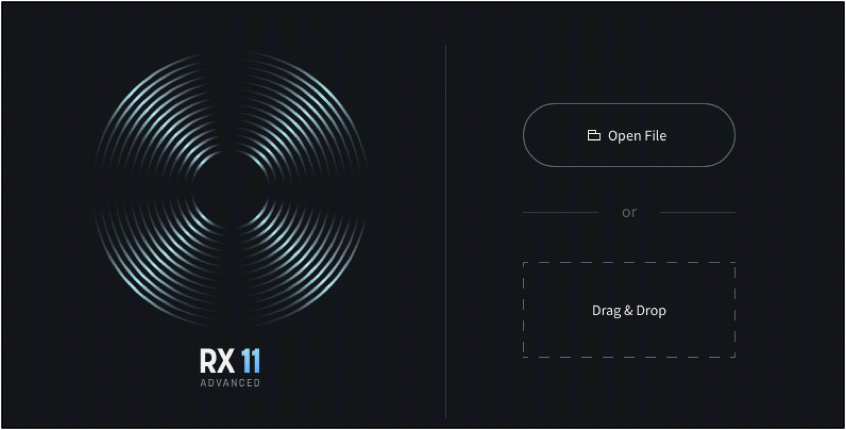

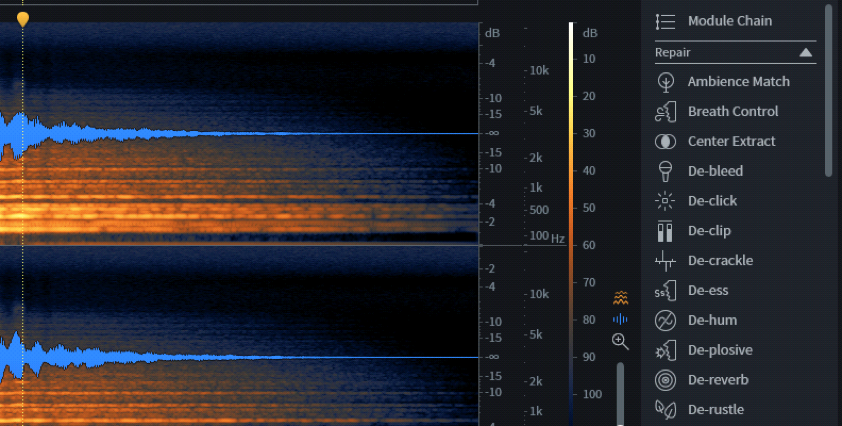
Price:
The perpetual license of iZotope RX is available in three versions:
RX Elements is the basic and more limited version. It only includes six plug-ins: Repair Assistant, Voice De-noise, De-click, De-clip, De-hum, and De-reverb. It does not feature the RX Audio Editor, so you can only use it as a plug-in. A license for Mac and PC costs $99.
RX Standard includes the RX Audio Editor, everything from the Elements version, and 12 more plug-ins, such as Dialogue Isolate, Music Rebalance, Spectral Editor, and Loudness Optimize. The single-use license is $399 for Mac and Windows.
RX Advanced is the most complete version, including the standalone editor plus 20 plug-ins featuring Dialogue Isolate with Dialogue De-reverb, Dialogue Isolate with multi-band processing, Streaming Preview, Dialogue Contour, Ambience Match, and everything from the Standard and Elements. The Advanced version is $1199.
If you want a subscription option, the iZotope Music Production Suite Pro includes RX with more iZotope plug-ins that can be used in the RX Audio Editor. The Music Production Suite Pro subscription is $19.99 monthly or $199 annually with a 7-day trial.
Pros:
- It features a wide range of noise reduction, dialogue cleanup, and audio restoration modules.
- Industry-standard software.
- Spectral editing provides audio manipulation with more precision.
- Machine learning algorithms streamline vocal and dialogue isolation.
- Clean and intuitive user interface.
Cons:
- Price.
- The steep learning curve for the more advanced features.
- It is CPU intensive, especially when using RX as a plug-in and working with larger audio files.
- Users report issues with the plug-in version, especially with video editing software.
iZotope RX vs CrumplePop Comparison Table
| Feature | iZotope RX | CrumplePop |
| Main Features | Audio editor, repair assistant, dialogue isolation, spectral editor. | Voice Enhance, AI-powered plug-ins for noise reduction, desktop and plug-in versions, and levels optimization. |
| Operating System | Windows and Mac | Windows and Mac |
| Pricing | Elements $99Standard $399Advanced $1199Subscription: $19.99 monthly or $199 annually. | Single host$18 monthly or $180 yearly.Multi-host$29 monthly or $276 yearly.Perpetual license $599 |
| Compatibility | Major compatibility with DAWs and audio editors, but stability issues when used within video editing software. | Major compatibility with hosts that support VST3, AU, and AAX third-party plug-ins, including video editing software. |
| Ease of Use | Powerful but can be complex for beginners with its steeper learning curve. | Zero audio knowledge is required. Simple to use and learn. |
| Best for | Audio engineers, music producers, and sound designers. | Podcasters, content creators, audio and video editors. |
| Plug-in version | Yes | Yes |
| Standalone app | Yes | Yes |
What is the Difference Between iZotope RX and CrumplePop?
Now that you're more familiar with CrumplePop and iZotope RX, I wanted to highlight some of their main differences, which might be decisive when choosing an audio repair tool.
-
Price
When dealing with two interesting and powerful tools like CrumplePop and RX, your budget may be a decisive factor. The subscription plans are around the same price, but for those who don't like subscriptions and prefer to get a full license, the price gap is considerable. The flagship RX version is usually $1199 against $599 for CrumplePop Complete.
-
Features
Another difference is that iZotope RX features more modules than CrumplePop. These advanced modules are designed for professional music production, mixing, and mastering. However, they have a steeper learning curve and may discourage beginners or editors who prefer to learn faster with easy-to-use tools.
-
Ease of Use
As I've mentioned, CrumplePop is the more beginner-friendly of the two. It works fast and efficiently, and the plug-in does most of the work with occasional adjustments by the user. RX UI is intuitive but still a bit complex compared to CrumplePop.
-
Plug-in Compatibility
Both audio repair tools are compatible with DAWs as long as they support AU, AAX, and VST3 plug-ins. However, iZotope RX has reports of instability when using the modules as plugins from video editing software such as Premiere Pro and DaVinci Resolve.
-
Vocal and Instrument Isolation
Using the iZotope RX 11 Music Rebalance module, you can isolate vocals and control volumes between instruments using a single slider. It offers more variety for music production than CrumplePop's Voice Enhance. However, the latter is designed for audio dialogue and focuses on the vocal part, not instrumentations, delivering outstanding vocal isolation.
Final Words
Both CrumplePop and iZotope RX are strong, versatile, and reliable audio restoration tools. So which one should you use? Here's a quick summary if you still need to decide.
Choose CrumplePop if you work mostly with video, podcasts, and dialogue recordings and must repair common issues. It is also a good choice if you prefer a simple tool and don't require more advanced features such as spectral editing and multi-band processing.
Go for iZotope RX if you need a comprehensive audio toolkit for more professional audio restoration in broadcast or music production. Another reason to consider RX is if you must use advanced features like spectral editing and are more familiar with complex audio tools or are willing to take the time to learn.
Remember that both audio tools have a free trial to download to see which fits your workflow and style. Try the same audio file and find the answer for yourself.
Good luck!





